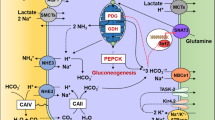Abstract.
The cotransport of protons and peptides is now recognised as a major route by which dietary nitrogen is absorbed from the intestine, and filtered protein reabsorbed in the kidney. Recently, molecular biology has had a very substantial impact on the study of peptide transport, and here we review the molecular and functional information available within the framework of physiology. To this end we consider not only the mammalian peptide transporters and their tissue distribution and regulation but also those from other species (including Caenorhabditis elegans) which make up the proton-dependent oligopeptide transport superfamily. In addition, understanding the binding requirements for transported substrates may allow future design and targeted tissue delivery of peptide and peptidomimetic drugs. Finally, we aim to highlight some of the less well understood areas of peptide transport, in the hope that it will stimulate further research into this challenging yet exciting topic.
Similar content being viewed by others
Author information
Authors and Affiliations
Additional information
Received 12 October 1999; received after revision 16 December 1999; accepted 15 January 2000
Rights and permissions
About this article
Cite this article
Meredith*, D., Boyd, C. Structure and function of eukaryotic peptide transporters . CMLS, Cell. Mol. Life Sci. 57, 754–778 (2000). https://doi.org/10.1007/s000180050040
Issue Date:
DOI: https://doi.org/10.1007/s000180050040




